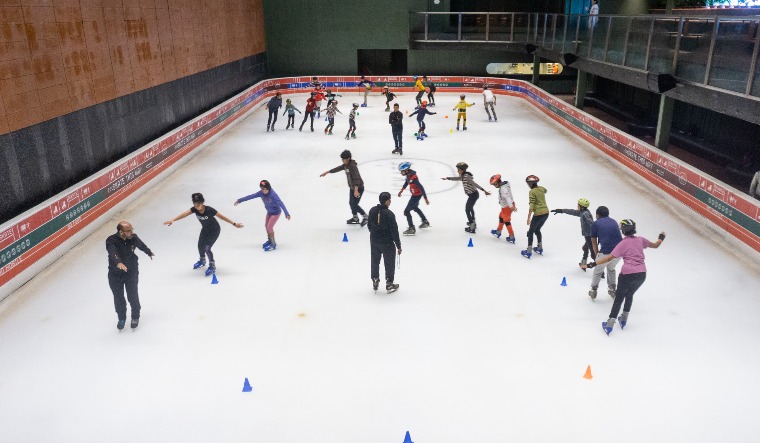Ice skating, the entertainment and game of coasting across an ice surface on sharp edges fixed to the bottoms of shoes (skates). The action of ice skating has brought about two unmistakable games: figure skating, which includes the exhibition of different leaps, twists, and dance developments; and speed skating and short-track speed skating, the two of which are types of dashing on ice skates. Ice hockey is the most popular group activity that includes skating.
Ice skating most likely evolved in Scandinavia as soon as 1000 BCE, the primary skates being produced using knife or rib bones of elk, bulls, reindeer, and different creatures. It isn't known when the metal sprinter was presented, however early Dutch prints portray skates with metal sharp edges. Until the center of the nineteenth century the metal piece of the skate was secured to a wooden base or footplate and the entire of the skate was attached to the foot with calfskin straps or lashes. A significant improvement came from the United States in 1850 when E.W. Bushnell of Philadelphia presented the all-steel skate, which supplanted the lumbering wooden footplate. The primary improvements in the figure skate after 1900 were the option of the toe pick, a gathering of sawlike teeth situated at the toe of the sharp edge, which empowered skaters to get better buy in the ice while doing specific leaps, and the development of the "shut toe" cutting edge of one-piece steel, which added solidarity to the skate and allowed a lot lighter-weight cutting edge.
The contemporary figure skate, which is the sort the most ideal for general delight skating as well with respect to figure skating, is effortlessly recognized from different coasts by the toe pick at the front of its sharp edge. The sharp edge itself is around 4 mm (around 0.157 inch) wide. An empty edge along the cutting edge underlines its two honed external edges; these are the surfaces on which skating developments are made. The cutting edge is roughly a similar length as the boot or shoe to which it is joined. The boot, which is normally dark for men and white for ladies, has serious areas of strength for a, curve support and a solidifying material around the heel and under the curve. The speed skate is low profile, taking into account more liberated development of the lower leg. Its edge is significantly longer than the shoe (for the most part somewhere in the range of 42 and 46 cm [16.5 and 18 inches] long for men) and just 1 mm (0.039 inch) thick. The hockey skate is a hard, defensive boot with a short cutting edge that is bended at the finishes to take into consideration speedy turns.
As an entertainment skating has been constantly drilled on the waterways of the Netherlands since the Middle Ages by the two guys and females. Skating on the frozen lakes and fens was well known in England in the seventeenth 100 years, and the principal skating club was shaped in Edinburgh, Scotland, in 1742. During the 1740s British servicemen acquainted ice skating with North America. It was additionally famous at the French court around 1776; Marie-Antoinette was among the skaters. Napoleon Bonaparte skated at Auxerre in 1781.
The improvement of refrigerated ice arenas began the change of ice skating from an occasional side interest to a significant game and diversion. The main arena with misleadingly frozen ice, a confidential one, the Glaciarium, was opened in London in 1876. The principal misleadingly frozen arena in the United States was introduced in the old Madison Square Garden in New York City in 1879. All through the century an ever increasing number of public arenas with misleadingly delivered ice showed up. The capacity to make sheets of ice inside huge fields led to both skating sports and ice shows, which turned into a well known family diversion in the twentieth hundred years. It likewise considered ice skating to spread to locales with warm environments.
Sports including ice skating alone were coordinated by the National Skating Association of Great Britain (1879), the National Amateur Skating Association of the United States (1886), and the Amateur Skating Association of Canada (1888). These gatherings, with other public gatherings shaped meanwhile, established in 1892 the International Skating Union (ISU), which from that point turned into the world administering body for speed skating, ice moving, and figure skating. Big showdowns had started during the 1890s for speed skating (men just) and figure skating. Ladies' speed-skating big showdowns were first held in 1936. Figure skating for men, ladies, and matches was remembered for the Olympic program at the 1908 Games in London, and other skating occasions were added later: speed skating for men in 1924 and for ladies in 1960; ice moving in 1976; and short-track speed skating in 1992. The ascent in prominence of ice hockey from its mid-nineteenth century starting points harmonized with that of unadulterated skating during the 1920s. Ice hockey showed up in the Summer Olympics in 1920 and was remembered for the Winter Games upon their introduction in 1924. In 1998 ladies' hockey made its Olympic presentation.


0 Comments